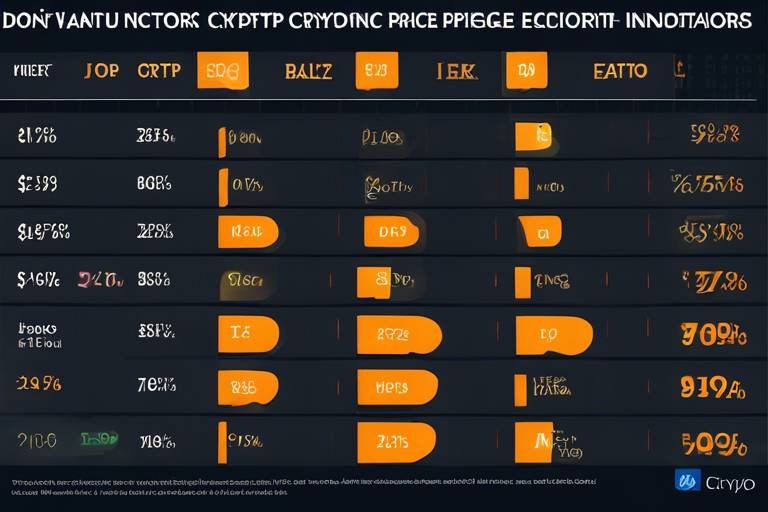How to Use Trading Bots in Cryptocurrency Markets
In the fast-paced world of cryptocurrency trading, the use of trading bots has gained significant traction among both novice and experienced traders. These automated tools can execute trades on behalf of users, analyzing market trends and making decisions based on predefined algorithms. Imagine having a tireless assistant who works around the clock, seizing opportunities and making trades while you sleep or go about your daily activities. This article explores the effective use of trading bots in cryptocurrency markets, detailing their advantages, types, setup processes, and strategies for maximizing returns while minimizing risks.
So, what exactly are trading bots? At their core, trading bots are automated software programs that take the guesswork out of trading. They analyze vast amounts of market data, allowing traders to capitalize on opportunities without the need for constant monitoring. By employing algorithms that can react to market changes in real-time, trading bots can execute trades at lightning speed, making them invaluable in the volatile world of cryptocurrencies. This automation not only saves time but also reduces emotional trading decisions, which can often lead to losses.
When it comes to trading bots, one size does not fit all. There are various types of trading bots, each designed for specific trading strategies. Understanding these types can help traders select the most suitable bot for their investment goals and risk tolerance. Let's delve into some of the most popular types of trading bots:
Market making bots are like the friendly neighborhood liquidity providers. They work by placing buy and sell orders simultaneously, profiting from the bid-ask spread. This makes them ideal for traders looking to earn consistent returns, especially in volatile markets. By providing liquidity, these bots help maintain a healthy trading environment, ensuring that there are always buyers and sellers available.
On the other hand, arbitrage bots are the opportunists of the trading world. They exploit price discrepancies across different exchanges. Picture this: a cryptocurrency is priced lower on one platform and higher on another. An arbitrage bot swoops in, buying low on one exchange and selling high on another, securing profits with minimal risk. However, speed is crucial here; the window of opportunity can close in seconds!
Ready to dive into the world of trading bots? Setting one up involves a few key steps. First, you need to select the right software. There are numerous options available, each with its own features and capabilities. Once you've chosen your bot, you'll connect it to your exchange account. This is where the magic happens! You'll then configure parameters such as trading pairs, risk management settings, and investment amounts to tailor the bot to your specific needs.
Choosing a trustworthy trading platform is crucial for successful bot trading. Consider factors such as:
- Security Features: Ensure the platform has robust security measures in place.
- Available Trading Pairs: Look for a platform that offers the cryptocurrencies you want to trade.
- Fees: Be aware of the transaction fees that can eat into your profits.
- User Experience: A user-friendly interface can make a significant difference in your trading experience.
Once your bot is connected, configuring effective trading strategies is essential for maximizing its performance. Think of it as setting the rules of a game. Define your risk appetite, profit targets, and trading frequency to align the bot's operations with your investment goals. A well-configured bot is like a well-oiled machine, working tirelessly to achieve your desired outcomes.
Even the best trading bots require regular monitoring and adjustments. Just like a car needs maintenance, your bot's performance should be analyzed periodically. Track the results, make necessary tweaks, and stay informed about market changes to optimize your strategies. This proactive approach can help you stay ahead of the curve and adapt to the ever-evolving cryptocurrency landscape.
While trading bots can enhance efficiency, they are not without risks. It's crucial to be aware of potential pitfalls, such as:
- Technical Failures: Software glitches can lead to unexpected losses.
- Market Volatility: Rapid price changes can affect trading outcomes.
- Over-optimization: Tweaking settings too much can lead to poor performance.
Understanding these risks helps traders make informed decisions and protect their investments.
To ensure your trading bot is a success, consider implementing some best practices. Start with small investments to test the waters, diversify your strategies to spread risk, and continuously educate yourself about market trends and bot capabilities. Remember, the market is always changing, and keeping your knowledge up to date can give you a competitive edge.
Q: Can anyone use trading bots?
A: Yes! Trading bots are designed for both novice and experienced traders. However, a basic understanding of trading principles is beneficial.
Q: Are trading bots guaranteed to make profits?
A: No trading bot can guarantee profits. While they can enhance trading efficiency, market conditions can be unpredictable.
Q: Do I need to monitor my trading bot continuously?
A: While trading bots automate the trading process, regular monitoring is essential to ensure optimal performance and make necessary adjustments.

Understanding Trading Bots
Trading bots are revolutionary tools that have transformed the way individuals engage with the cryptocurrency markets. Imagine having a tireless assistant who works around the clock, analyzing market trends and executing trades without the need for constant supervision. That's precisely what trading bots do! They are automated software programs designed to execute trades on behalf of users, employing sophisticated algorithms to make informed decisions based on market data.
One of the significant advantages of using trading bots is their ability to analyze vast amounts of data far more quickly than a human ever could. While you might be sipping your morning coffee, a trading bot is scanning the market for profitable opportunities, reacting in real-time to price changes and market fluctuations. This capability enables traders to capitalize on opportunities that might otherwise be missed, particularly in the fast-paced world of cryptocurrency trading.
Moreover, trading bots can operate based on predefined strategies that align with your investment goals. Whether you're a day trader looking to make quick profits or a long-term investor aiming for gradual growth, there's a bot tailored to suit your needs. They can execute trades based on various factors, including technical indicators, market sentiment, and historical data, allowing for a level of precision that can be challenging to achieve manually.
However, it's essential to understand that while trading bots can enhance trading efficiency, they are not a guaranteed path to success. Just like any tool, their effectiveness depends on how well they are configured and the strategies employed. Traders must remain vigilant, regularly monitoring their bots' performance and making necessary adjustments to ensure they align with ever-changing market conditions.
In summary, trading bots are an exciting development in the cryptocurrency landscape, offering a blend of automation and strategic trading. By leveraging these tools, traders can potentially increase their returns while minimizing the time and effort required to manage their investments actively. As with any trading approach, understanding how these bots work and the strategies behind them is crucial for achieving the best results.

Types of Trading Bots
When it comes to navigating the bustling world of cryptocurrency trading, understanding the different types of trading bots is crucial. These automated tools are designed to execute trades based on specific strategies, allowing traders to capitalize on opportunities without being glued to their screens. Each type of trading bot serves a unique purpose, catering to various trading strategies and market conditions. By familiarizing yourself with these bots, you can select the one that aligns with your investment goals and risk tolerance.
One of the most popular types of trading bots is the Market Making Bot. These bots play a vital role in providing liquidity to the markets by placing simultaneous buy and sell orders. They profit from the bid-ask spread, which is the difference between the buying price and the selling price. Imagine a bustling marketplace where vendors are constantly adjusting their prices to attract buyers; market-making bots operate in a similar fashion. They thrive in volatile markets, making them ideal for traders looking to earn consistent returns while minimizing risk.
Another significant category is the Arbitrage Bot. These bots are like savvy shoppers who scour various stores for the best deals. They exploit price discrepancies across different exchanges by buying low on one platform and selling high on another. This strategy allows traders to secure profits with minimal risk, provided they act quickly. However, timing is everything; the market can change in the blink of an eye, and these bots must be programmed to execute trades swiftly to take advantage of fleeting opportunities.
There are also Trend Following Bots, which analyze market trends and execute trades based on the direction of the market. These bots are designed to identify upward or downward trends and make trades that align with those movements. They operate under the principle that "the trend is your friend," allowing traders to ride the wave of market momentum. However, it's essential to note that trend-following strategies can lead to losses if the market reverses unexpectedly.
Additionally, you might encounter Mean Reversion Bots. These bots operate on the premise that prices will revert to their historical averages over time. They buy assets that are undervalued and sell those that are overvalued, aiming to profit from price corrections. This strategy can be effective in stable markets but may pose risks during periods of high volatility.
To summarize, here's a quick overview of the primary types of trading bots:
| Type of Bot | Function | Ideal For |
|---|---|---|
| Market Making Bot | Provides liquidity, profits from bid-ask spread | Traders seeking consistent returns |
| Arbitrage Bot | Exploits price discrepancies across exchanges | Traders looking for quick profits |
| Trend Following Bot | Trades based on market momentum | Traders who follow market trends |
| Mean Reversion Bot | Trades based on historical price averages | Traders in stable markets |
Understanding these different types of trading bots can empower you to make informed decisions about which one to use. Each bot has its unique strengths and weaknesses, and your choice should reflect your trading style, risk appetite, and market conditions. By leveraging the right bot, you can enhance your trading efficiency and potentially increase your returns.
- What is a trading bot? A trading bot is an automated software program that executes trades on behalf of users based on predefined algorithms.
- Are trading bots safe? While trading bots can enhance efficiency, they come with risks such as technical failures and market volatility.
- How do I choose the right trading bot? Consider factors like your trading strategy, risk tolerance, and the specific features of the bot.
- Can I use multiple trading bots? Yes, many traders use multiple bots to diversify their strategies and optimize their trading performance.

Market Making Bots
Market making bots are fascinating tools in the world of cryptocurrency trading, acting as the unsung heroes that provide liquidity to the market. Imagine a bustling marketplace where buyers and sellers are constantly negotiating prices. Market making bots step in to ensure that there is always a buyer for every seller and vice versa, effectively keeping the market flowing smoothly. These bots operate by placing simultaneous buy and sell orders, profiting from the bid-ask spread. This is the difference between the price a buyer is willing to pay and the price a seller is asking for. By capitalizing on these small price differences, market making bots can generate consistent returns for their users, even in volatile markets.
One of the key advantages of utilizing market making bots is their ability to operate 24/7 without the need for human intervention. This means that while you’re sleeping or enjoying a day off, your bot is working diligently to take advantage of market fluctuations. It’s like having a tireless assistant who never tires of seeking out the best deals! However, it’s important to understand that while these bots can be profitable, they also come with their own set of challenges.
For example, market making bots require a solid understanding of market dynamics and effective risk management strategies. Traders must set parameters carefully to avoid potential pitfalls, such as liquidity crises or significant market shifts. Here’s a quick overview of some essential factors to consider when using market making bots:
| Factor | Description |
|---|---|
| Liquidity | Ensure there is sufficient trading volume in the selected market to avoid slippage. |
| Spread | Monitor the bid-ask spread to maximize profit potential. |
| Risk Management | Set stop-loss orders and define the maximum amount you are willing to risk. |
By carefully considering these factors, traders can enhance their market making strategies and increase the likelihood of success. It’s also crucial to stay updated with market trends and emerging technologies that could impact trading dynamics. Just like a seasoned chef constantly refines their recipes, traders should continuously optimize their bot settings to adapt to the ever-changing market landscape.
In conclusion, market making bots serve as powerful allies for traders looking to navigate the complexities of cryptocurrency markets. They offer a way to generate profits through consistent trading activity, but they require diligence, strategy, and a proactive approach to risk management. With the right setup and ongoing adjustments, these bots can significantly enhance your trading experience.
- What is a market making bot? A market making bot is an automated trading tool that places buy and sell orders simultaneously to provide liquidity and profit from the bid-ask spread.
- How do market making bots make money? They profit from the difference between the buying and selling prices of assets, known as the bid-ask spread.
- Are market making bots risky? Yes, they come with risks such as market volatility and the potential for technical failures. Proper risk management is essential.
- How can I optimize my market making bot? Regularly monitor its performance, adjust parameters based on market conditions, and stay informed about market trends.

Arbitrage Bots
Arbitrage bots are a fascinating tool in the world of cryptocurrency trading, designed to capitalize on the price differences that can occur between various exchanges. Imagine this: you spot a particular cryptocurrency, let’s say Bitcoin, trading for $30,000 on Exchange A while it’s listed for $30,500 on Exchange B. An arbitrage bot can swiftly buy Bitcoin on Exchange A and sell it on Exchange B, pocketing the difference. This is the essence of arbitrage—seizing opportunities that arise from market inefficiencies.
The beauty of arbitrage bots lies in their speed and efficiency. In the fast-paced world of crypto trading, timing is everything. These bots operate in milliseconds, executing trades faster than any human could. They continuously monitor multiple exchanges, scanning for price discrepancies and executing trades when they find a profitable opportunity. This automated approach not only saves time but also minimizes the emotional factors that can cloud judgment in trading decisions.
However, while arbitrage trading may sound like a foolproof strategy, it’s not without its challenges. One of the primary hurdles traders face is the transaction fees associated with trading on different platforms. If the price difference is small and the fees are high, the potential profit can evaporate quickly. Therefore, successful arbitrage trading requires careful calculation and consideration of fees. Here's a simple breakdown:
| Exchange A | Exchange B | Price Difference | Transaction Fees | Net Profit |
|---|---|---|---|---|
| $30,000 | $30,500 | $500 | $50 | $450 |
| $30,200 | $30,500 | $300 | $50 | $250 |
In the table above, you can see how the net profit is affected by transaction fees. The first scenario yields a decent profit, while the second shows that even a small fee can significantly reduce earnings. This is why it’s crucial to choose exchanges with competitive fees and to keep an eye on the overall market conditions.
Moreover, arbitrage opportunities can disappear as quickly as they arise. The more traders that enter a market, the more efficient it becomes, which means the price discrepancies may vanish almost instantly. This is why having an arbitrage bot is so advantageous—it allows you to act on fleeting opportunities without the need for constant manual intervention.
In conclusion, arbitrage bots represent a powerful strategy for traders looking to exploit market inefficiencies. They provide a way to make profits with relatively low risk, provided that traders are aware of the potential pitfalls. As with any trading strategy, success with arbitrage requires a combination of the right tools, market knowledge, and a bit of luck.
- What is an arbitrage bot? An arbitrage bot is an automated trading program that identifies and capitalizes on price differences for the same asset across different exchanges.
- Are arbitrage bots profitable? Yes, they can be profitable, but the success depends on factors like transaction fees and market conditions.
- Do I need to monitor the bot constantly? While bots operate automatically, it's wise to monitor their performance and market conditions periodically to ensure optimal results.
- Can anyone use an arbitrage bot? Yes, anyone with access to cryptocurrency exchanges can use arbitrage bots, but a basic understanding of trading and market dynamics is beneficial.

Setting Up a Trading Bot
Setting up a trading bot may sound daunting, but it's actually a straightforward process that can open up a world of opportunities in the cryptocurrency markets. The first step is to choose the right trading software. There are numerous options available, each with its own features and benefits. It's crucial to select a bot that aligns with your trading goals and technical expertise. For example, some bots are designed for beginners, featuring user-friendly interfaces, while others cater to advanced traders with complex algorithms and customizable settings.
Once you've selected your trading bot, the next step is to connect it to your exchange account. This usually involves creating an API key on your trading platform, which allows the bot to execute trades on your behalf. It's essential to ensure that you only grant the necessary permissions to the bot, such as trading access, without exposing sensitive information like your withdrawal capabilities. This is akin to giving someone the keys to your house but only allowing them to enter the living room—safety first!
After establishing the connection, you'll need to configure various parameters to tailor the bot's performance to your preferences. This includes selecting the trading pairs you wish to focus on, determining your risk management settings, and deciding on your investment amounts. For instance, if you're particularly bullish on Bitcoin and Ethereum, you might set up your bot to trade these pairs exclusively. Additionally, defining your risk appetite is vital; will you opt for aggressive trading strategies or a more conservative approach? Think of this as setting the rules of a game before you start playing.
Moreover, it's important to regularly revisit these configurations as market conditions change. The cryptocurrency landscape is notoriously volatile, and what works today may not be effective tomorrow. By keeping an eye on your bot's performance and adjusting your strategies accordingly, you can maximize your chances of success. This is similar to tuning a musical instrument; a little adjustment can make a world of difference in the final performance.
In summary, setting up a trading bot involves selecting the right software, securely connecting it to your exchange, and carefully configuring your trading parameters. By following these steps and remaining adaptable to market changes, you can harness the power of trading bots to enhance your trading experience and potentially increase your profits.

Choosing the Right Platform
When it comes to trading bots, selecting the right platform is not just a step; it’s a crucial leap toward your trading success. Imagine you’re about to embark on a thrilling journey through the cryptocurrency markets. Would you choose a rickety old boat or a sturdy, reliable ship? The same logic applies here. A trustworthy trading platform can make all the difference in your trading experience.
First and foremost, you want to consider the security features of the platform. In a world where cyber threats are lurking around every corner, ensuring that your funds and personal information are safe should be your top priority. Look for platforms that offer two-factor authentication, encryption protocols, and a solid reputation among the trading community. After all, would you trust your hard-earned money with a platform that has a questionable security record?
Next, think about the available trading pairs. Not all platforms support the same cryptocurrencies, and having a diverse range of options can be a game-changer for your trading strategy. For instance, if you’re interested in trading lesser-known altcoins, you’ll want to choose a platform that offers a wide selection. It’s like having a toolbox: the more tools you have at your disposal, the better equipped you are to tackle any situation.
Another critical factor is the fee structure. Some platforms charge hefty fees for trades, withdrawals, or deposits, which can eat into your profits faster than you can say “blockchain.” Always take the time to read the fine print and understand the fee structure of the platform you’re considering. A platform that seems cheap at first glance may have hidden fees that can surprise you later. Transparency is key, just like in any good relationship!
Finally, user experience is paramount. A platform that is intuitive and easy to navigate can save you time and frustration. Look for features like a customizable dashboard, real-time analytics, and responsive customer support. You wouldn’t want to be stuck in a maze when you’re trying to make quick trades, right? A smooth user experience can significantly enhance your trading efficiency and make your journey through the cryptocurrency world much more enjoyable.
In summary, choosing the right trading platform is like picking the right partner for a dance. You want someone who complements your moves, keeps you safe, and makes the experience enjoyable. By focusing on security, available trading pairs, fees, and user experience, you’ll set yourself up for success in the dynamic world of cryptocurrency trading.

Configuring Trading Strategies
When it comes to for your trading bot, the process can feel a bit like setting the stage for a grand performance. You want to ensure every element is in place to capture the audience's (or in this case, the market's) attention and maximize your returns. First and foremost, it's crucial to define your risk appetite. Are you a conservative trader looking to avoid significant losses, or are you more of a thrill-seeker, willing to take on greater risks for the chance of higher rewards? This self-assessment will guide your strategy configuration.
Next, consider setting profit targets. Think of these as your finish lines. How much profit do you want to achieve before you decide to cash out? Setting clear targets helps the bot understand when to execute trades and when to hold back. Additionally, you’ll want to determine your trading frequency. Are you looking to make trades multiple times a day, or do you prefer a more laid-back approach with fewer transactions? This decision will influence how aggressively your bot operates.
Once you've established these parameters, it's time to dive into the specifics of your trading strategy. This is where you can get creative! For instance, you might choose to implement a trend-following strategy, where the bot identifies and capitalizes on upward or downward market trends. Alternatively, you could opt for a mean-reversion strategy, where the bot looks for assets that have deviated from their average price and bets on their return to that average.
To make things clearer, let’s take a look at a simple table that outlines different strategies and their characteristics:
| Strategy Type | Description | Risk Level |
|---|---|---|
| Trend-Following | Capitalizes on market momentum by buying high and selling higher. | Medium |
| Mean-Reversion | Assumes prices will revert to their average over time. | Low |
| Scalping | Makes numerous small trades to accumulate profits. | High |
| Arbitrage | Takes advantage of price discrepancies across exchanges. | Medium |
As you configure your trading bot, it’s essential to continuously test and refine your strategies. The market is a dynamic environment, and what works today might not work tomorrow. Backtesting your strategies with historical data can provide insights into their potential effectiveness, allowing you to make adjustments before putting real money on the line.
Finally, don't forget to keep an eye on the market conditions. Economic news, regulatory changes, and technological advancements can all impact trading strategies. By staying informed and being flexible, you can help your bot adapt to changing environments, ensuring it performs optimally no matter the circumstances.
- What is a trading bot? A trading bot is an automated software program that executes trades on behalf of the user based on predefined algorithms.
- How do I choose the right trading strategy? Assess your risk tolerance, define profit targets, and consider your trading frequency to select a strategy that aligns with your goals.
- Can trading bots guarantee profits? No, while trading bots can enhance efficiency, they do not guarantee profits due to market volatility and other risks.
- How often should I monitor my trading bot? Regular monitoring is essential, especially during volatile market conditions. Adjustments may be needed based on performance and market changes.

Monitoring and Adjusting Bot Performance
When it comes to trading bots, the journey doesn't end once you've set everything up and clicked that 'start' button. In fact, that’s just the beginning! Regularly monitoring and adjusting your bot's performance is crucial for ensuring that your investments are on the right track. Just like a gardener tends to their plants, you need to nurture your trading bot to help it thrive in the ever-changing landscape of the cryptocurrency market.
Imagine you’ve planted a seed. At first, it might seem like nothing is happening, but with time and attention, it can blossom into something beautiful. Similarly, your trading bot requires your attention to adapt to market fluctuations. You should keep a close eye on its performance metrics to see how well it’s executing trades. Are you hitting your profit targets? Is the bot making too many trades, or is it sitting idle? These questions are essential for evaluating its effectiveness.
One effective way to monitor your bot is by analyzing its trading history. Most trading platforms provide detailed logs where you can view each trade the bot has executed. Pay attention to key metrics such as:
- Win Rate: The percentage of profitable trades versus total trades.
- Average Profit per Trade: How much you earn on average for each successful trade.
- Maximum Drawdown: The largest drop from a peak to a trough in your investment value.
These metrics act as a health check for your bot. If you notice a decline in any of these areas, it might be time for a reassessment. Adjusting your bot's parameters can make a significant difference. For instance, you might want to tweak the risk management settings or change the trading pairs to optimize performance. Think of it as recalibrating a compass; a small adjustment can lead you back on course.
It's also vital to stay informed about market changes. Cryptocurrency markets are notoriously volatile, and what worked yesterday might not work today. Regularly reviewing market trends, news, and updates can provide valuable insights that can be implemented into your bot’s trading strategy. This proactive approach can prevent potential losses and maximize gains.
Furthermore, consider setting up alerts or notifications to keep you updated on your bot's performance without needing to check manually all the time. Most trading platforms allow you to customize alerts for specific performance thresholds, so you can be informed when your bot needs your attention. This way, you can focus on other tasks while still keeping a finger on the pulse of your investments.
In summary, monitoring and adjusting your trading bot is not just a one-time task; it’s an ongoing process. By regularly analyzing its performance, making necessary adjustments, and staying informed about market conditions, you can significantly enhance your trading experience and increase your chances of success in the cryptocurrency markets.
Q1: How often should I monitor my trading bot?
A1: It's recommended to monitor your bot at least once a week, but you may want to check more frequently if the market is particularly volatile.
Q2: What should I do if my bot is underperforming?
A2: Analyze the trading history for patterns, adjust your strategies, and ensure that your settings align with current market conditions.
Q3: Can I run multiple trading bots simultaneously?
A3: Yes, running multiple bots can diversify your strategies, but make sure to monitor each one to avoid potential losses.

Risks of Using Trading Bots
While trading bots can significantly enhance trading efficiency and help capitalize on market opportunities, they are not without their risks. Understanding these risks is crucial for any trader looking to employ automated strategies. One of the primary concerns is technical failures. Just like any software, trading bots can experience glitches or bugs that might lead to unexpected trading outcomes. Imagine setting up your bot to make a profit, only to find it executing trades incorrectly due to a programming error. This can result in substantial financial losses, especially in the volatile world of cryptocurrency.
Another significant risk is market volatility. The cryptocurrency market is known for its rapid price fluctuations. A trading bot, while programmed to react to market conditions, may not be able to adapt quickly enough to sudden changes. For instance, if a bot is set to sell a cryptocurrency at a specific price point, a sudden market crash could mean that the bot fails to execute the trade in time, leading to losses. Traders must remain aware that no bot is infallible and that market conditions can change in the blink of an eye.
Moreover, there is the danger of over-optimization. This occurs when traders tweak their bot's settings too much based on historical data, creating a "perfect" strategy that may not perform well in real-time trading. It's akin to trying to predict the weather by only looking at past patterns; what worked yesterday may not work today. Traders should maintain a balanced approach, ensuring that their strategies are adaptable rather than rigidly optimized for specific scenarios.
Additionally, security risks cannot be overlooked. When connecting a trading bot to an exchange, you are essentially granting it access to your funds. If the bot or the exchange suffers from a security breach, your investments could be at risk. It's vital to choose reputable platforms and ensure that you are using bots with robust security measures in place.
In summary, while trading bots can offer a myriad of benefits, they also come with inherent risks. Traders should conduct thorough research and consider the following key points:
- Technical Failures: Bots can malfunction, leading to unexpected trading results.
- Market Volatility: Rapid price changes can hinder a bot's ability to execute trades effectively.
- Over-Optimization: Excessive tweaking can lead to poor performance in live trading.
- Security Risks: Connecting bots to exchanges may expose you to potential hacks.
By being aware of these risks, traders can make more informed decisions and implement strategies that help mitigate potential downsides. After all, in the world of cryptocurrency, knowledge is power, and being prepared can make all the difference between profit and loss.
What is a trading bot?
A trading bot is an automated software program that executes trades on behalf of users based on predefined algorithms and market analysis.
Are trading bots safe to use?
While trading bots can enhance trading efficiency, they come with risks such as technical failures and security vulnerabilities. It's crucial to choose reputable platforms and maintain security practices.
Can trading bots guarantee profits?
No, trading bots cannot guarantee profits. They can help traders capitalize on market opportunities, but they are subject to market conditions and inherent risks.
How do I choose the right trading bot?
Consider factors such as security features, user reviews, supported exchanges, and the bot's customization options to select the right trading bot for your needs.

Best Practices for Successful Bot Trading
When it comes to maximizing your success with trading bots in the cryptocurrency markets, implementing best practices can make a world of difference. Think of your trading bot as a high-performance vehicle. Just like you wouldn’t drive a sports car without understanding its features and capabilities, you shouldn’t dive into trading without a solid strategy. Here are some essential practices to keep in mind:
First and foremost, start small. It’s tempting to go all-in when you see the potential for quick profits, but this can lead to significant losses if things don’t go as planned. By starting with a modest investment, you can test the waters and understand how your bot operates without risking your entire capital. This approach allows you to learn from your mistakes and adjust your strategies accordingly.
Next, diversification is key. Just as you wouldn’t put all your eggs in one basket when investing in stocks, the same principle applies to trading bots. Consider using multiple bots that employ different strategies or trade various cryptocurrencies. This way, if one bot underperforms, others may compensate, reducing your overall risk. For instance, you might use a market-making bot alongside an arbitrage bot to balance your portfolio.
Another critical aspect is continuous education. The cryptocurrency market is constantly evolving, and staying informed about the latest trends, technologies, and market movements can give you a competitive edge. Regularly reading articles, attending webinars, and participating in community discussions can enhance your understanding and help you make better decisions. Think of it as tuning your vehicle; the better you know it, the more efficiently it will perform.
It’s also essential to monitor your bot’s performance regularly. Just because your bot is automated doesn’t mean you can set it and forget it. Keep an eye on its trades, analyze the results, and be prepared to make adjustments as needed. This might involve tweaking your trading parameters, changing strategies, or even switching to a different bot altogether. Regular check-ins can help you catch potential issues early and optimize your bot's performance.
Lastly, always be aware of the risks involved. Trading bots can enhance efficiency, but they’re not foolproof. Technical failures, market volatility, and the temptation to over-optimize can lead to unexpected outcomes. Understanding these risks allows you to make informed decisions and implement strategies that protect your investments. Consider setting stop-loss orders to minimize potential losses, just as you would wear a seatbelt for safety while driving.
In conclusion, successful bot trading requires a blend of strategy, education, and vigilance. By starting small, diversifying your strategies, continuously educating yourself, monitoring performance, and understanding risks, you can significantly enhance your chances of success in the exciting world of cryptocurrency trading.
- What are trading bots? Trading bots are automated software programs that execute trades on behalf of users based on predefined algorithms.
- Are trading bots safe to use? While trading bots can enhance trading efficiency, they come with risks such as market volatility and technical failures. Proper risk management is crucial.
- How do I choose the right trading bot? Consider factors such as the bot's performance history, user reviews, security features, and compatibility with your preferred exchange.
- Can trading bots guarantee profits? No, trading bots cannot guarantee profits. They are tools that can help automate trading strategies but do not eliminate risk.
- How often should I monitor my trading bot? Regular monitoring is essential. Check your bot’s performance at least weekly to ensure it aligns with your investment goals.
Frequently Asked Questions
- What are trading bots?
Trading bots are automated software programs that execute trades on behalf of users. They analyze market trends and make decisions based on predefined algorithms, which means you can capitalize on trading opportunities without having to monitor the markets constantly.
- How do I choose the right trading bot?
Choosing the right trading bot involves understanding your trading goals and risk tolerance. Look for bots that align with your investment strategy, whether it’s market making, arbitrage, or another type. Additionally, consider factors like user reviews, security features, and the bot’s performance history.
- Are trading bots safe to use?
While trading bots can enhance trading efficiency, they come with risks such as technical failures and market volatility. It's essential to choose reputable bots and continuously monitor their performance to minimize potential risks.
- Can I use a trading bot on any exchange?
Not all trading bots are compatible with every exchange. Ensure that the bot you choose supports the exchange you plan to use. Check the bot's documentation or website for a list of supported platforms.
- What is the best strategy for using trading bots?
The best strategy involves starting with small investments, diversifying your trading strategies, and regularly monitoring and adjusting the bot's performance. It’s also crucial to stay informed about market trends and continuously educate yourself on how the bot operates.
- How often should I monitor my trading bot?
While trading bots operate automatically, it's wise to monitor their performance regularly. Checking in daily or weekly allows you to make necessary adjustments and ensure the bot is aligned with your trading goals and market conditions.
- What are the common mistakes to avoid with trading bots?
Common mistakes include over-optimizing settings, not diversifying strategies, and neglecting to monitor performance. It's important to strike a balance between automation and oversight to ensure your trading bot is functioning effectively.


















